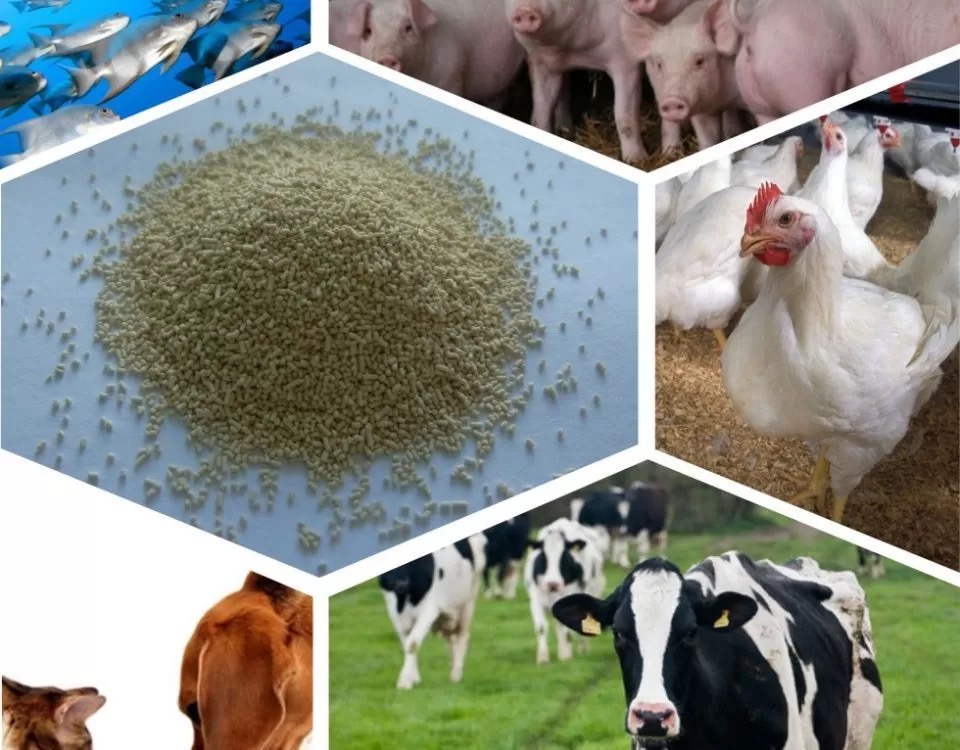Nowadays, there are approximately 8.07 billion people on the planet, and by the end of 2023, the population is projected to reach 8.15 billion. While the number of people on Earth is growing rapidly by more than 90 million people per year, the demand for food products, including meat, poultry and aquaculture products, is increasing too. Protein ingredients are required to provide the animal feed rations required for food production. It is important to consider both the quantity and quality of protein as it has a significant impact on productivity.
Deficiency of quality and available feed protein is one of the most urgent problems of modern animal husbandry. To normalize forages in terms of protein level, soybean products and fish meal are most often used.
Soy protein is of plant origin and is not a full-fledged substitute for proteins of animal origin due to differences in amino acid composition. At the same time, climatic conditions in Russia do not allow growing soya in sufficient quantities which leads to dependence on imported supplies. Due to the events of 2022, soya imports have been significantly reduced leading to a general deficiency and an increase in prices for this product.
Fishmeal production has been declining for many years in a row. This is due to the depletion of the world's ocean resources. At the same time, the demand for this product continues to grow. This leads to a significant increase in prices. But the main problem with fishmeal is its unstable quality, due to the fact that the composition of the catch is always different, as well as widespread adulteration. It is all too easy to mix fishmeal with feather meal, soya meal, meat and bone meal, bran or urea.
Rising prices, unstable quality and the risk of buying adulterated products are forcing producers to look for alternative protein sources to fully or partially replace traditional proteins in feed formulations. Some of the most studied and promising alternative feed protein sources to date are fungi (yeasts), bacteria, microalgae and insects.
The amino acid profile of entomoprotein is similar to meat protein. As a substrate for insect rearing, wastes from grain, oil and alcohol refineries, fruits and vegetables are used which corresponds to the principle of a cyclic production system. Recent changes in legislation significantly contribute to the development of this area. In July 2017, the European Commission approved the use of insect biomass-based additives in aquaculture feed, and since September 2021, insect protein has been authorized for use in poultry and pig feed. However, feed use is limited to only 7 insect species, including 3 species of crickets (Acheta domesticus, Gryllodes sigillatus, Gryllus assimilis), 2 species of mealworms (Tenebrio molitor, Alphitobiusdiaperinus) and 2 species of flies (Hermetia illucens, Musca domestica). In Russia, a number of companies are involved in research and production of entomoprotein: “Ecobelok”, “Entoprotek”, “Yamster”, etc.
There are a number of studies indicating the possibility of protein production by culturing unicellular microorganisms (bacteria, yeasts, algae) on relatively inexpensive substrates (starch, molasses and other by-products of grain processing, oil and fat, alcohol industry and hydrocarbons).
Cultivation of unicellular algae (chlorella) is considered to be an alternative to protein in aquaculture feeds. The crude protein content of microalgae is 40-60%. Chlorella reproduces very intensively under optimal conditions which allows for a short time to obtain a biomass increase 200 times greater than that of higher plants. Chlorella biomass growth occurs through photosynthesis, the substrate for reproduction is carbon dioxide and water which makes the production quite environmentally friendly. Chlorella is grown both in open water and in photobioreactors and fermenters. The cultivation of green unicellular algae to produce natural astaxanthin with increased bioavailability is relevant in the field of feed production for fish, birds and other species. Chlorella-based feed additives are produced in Russia by the following companies: “AquaSar”, “Amfor”, “Les”, etc.
Industrial cultivation of unicellular fungi allows obtaining a product with high protein content (mycoprotein) which can be used for the production of mixed fodder. By creating special cultivation conditions, it is possible to achieve a given amino acid profile, as well as the content of vitamins and trace elements in the product.
The main producers of feed yeast in our country are the following companies: “Biotrade”, “Peschansky Dry Feed Yeast Plant”, “Volzhsky Hydrolysis and Yeast Plant”, “Mamadysh Distillery”, “PK Petrovsky”, “Biofood”. Enterprises of brewing and baking industries produce feed protein from yeast products.
The most interesting and promising direction in the field of alternative proteins is the production of haprin - a protein based on natural gas. Such a product consists of protein by more than 75%, has stable quality and is safe for the environment. But the main advantage of this technology is that the scalability is not limited by the availability of raw materials. Thus, production can be scaled to tens and hundreds of thousands of tonnes per year. The development of the technology originated in the USSR in the 1980s, the production was suspended in the 1990s, and now there is a revival of the technology.
“GIPROBIOSYNTEZ” LLC has created a strain-producer - Methylococcus capsulatus GBS-15™ by selection, without the use of molecular-genetic modification methods. By its characteristics, it exceeds all known world analogues, a unique design of fermenter and automatic control system of technological process has been developed.
All these achievements have contributed to a real breakthrough in the development of technology. The company has developed a range of haprin-based products. DREAMFEED® product which is a biomass of inactivated cells of non-pathogenic methanotrophic methane-oxidizing bacteria based on Methylococcus capsulatus GBS-15 strain is proposed for production of mixed fodders and premixes. This product is a full-fledged substitute for premium grade fishmeal with better quality characteristics.
The main markets for the introduction of DREAMFEED® are aquaculture feeds, animal and poultry feeds and pet foods. This is primarily due to the fact that the product has the most similar amino acid composition to fish meal and is its full analogue.
A number of tests on replacement of fish meal with DREAMFEED® microbiological protein in feeds for young pigs, broiler chickens, sturgeon fish and trout has shown the economic feasibility of its partial replacement (up to 40% protein), zootechnical efficiency and positive impact on the main performance indicators.
Deficiency of quality and available feed protein is one of the most urgent problems of modern animal husbandry. To normalize forages in terms of protein level, soybean products and fish meal are most often used.
Soy protein is of plant origin and is not a full-fledged substitute for proteins of animal origin due to differences in amino acid composition. At the same time, climatic conditions in Russia do not allow growing soya in sufficient quantities which leads to dependence on imported supplies. Due to the events of 2022, soya imports have been significantly reduced leading to a general deficiency and an increase in prices for this product.
Fishmeal production has been declining for many years in a row. This is due to the depletion of the world's ocean resources. At the same time, the demand for this product continues to grow. This leads to a significant increase in prices. But the main problem with fishmeal is its unstable quality, due to the fact that the composition of the catch is always different, as well as widespread adulteration. It is all too easy to mix fishmeal with feather meal, soya meal, meat and bone meal, bran or urea.
Rising prices, unstable quality and the risk of buying adulterated products are forcing producers to look for alternative protein sources to fully or partially replace traditional proteins in feed formulations. Some of the most studied and promising alternative feed protein sources to date are fungi (yeasts), bacteria, microalgae and insects.
The amino acid profile of entomoprotein is similar to meat protein. As a substrate for insect rearing, wastes from grain, oil and alcohol refineries, fruits and vegetables are used which corresponds to the principle of a cyclic production system. Recent changes in legislation significantly contribute to the development of this area. In July 2017, the European Commission approved the use of insect biomass-based additives in aquaculture feed, and since September 2021, insect protein has been authorized for use in poultry and pig feed. However, feed use is limited to only 7 insect species, including 3 species of crickets (Acheta domesticus, Gryllodes sigillatus, Gryllus assimilis), 2 species of mealworms (Tenebrio molitor, Alphitobiusdiaperinus) and 2 species of flies (Hermetia illucens, Musca domestica). In Russia, a number of companies are involved in research and production of entomoprotein: “Ecobelok”, “Entoprotek”, “Yamster”, etc.
There are a number of studies indicating the possibility of protein production by culturing unicellular microorganisms (bacteria, yeasts, algae) on relatively inexpensive substrates (starch, molasses and other by-products of grain processing, oil and fat, alcohol industry and hydrocarbons).
Cultivation of unicellular algae (chlorella) is considered to be an alternative to protein in aquaculture feeds. The crude protein content of microalgae is 40-60%. Chlorella reproduces very intensively under optimal conditions which allows for a short time to obtain a biomass increase 200 times greater than that of higher plants. Chlorella biomass growth occurs through photosynthesis, the substrate for reproduction is carbon dioxide and water which makes the production quite environmentally friendly. Chlorella is grown both in open water and in photobioreactors and fermenters. The cultivation of green unicellular algae to produce natural astaxanthin with increased bioavailability is relevant in the field of feed production for fish, birds and other species. Chlorella-based feed additives are produced in Russia by the following companies: “AquaSar”, “Amfor”, “Les”, etc.
Industrial cultivation of unicellular fungi allows obtaining a product with high protein content (mycoprotein) which can be used for the production of mixed fodder. By creating special cultivation conditions, it is possible to achieve a given amino acid profile, as well as the content of vitamins and trace elements in the product.
The main producers of feed yeast in our country are the following companies: “Biotrade”, “Peschansky Dry Feed Yeast Plant”, “Volzhsky Hydrolysis and Yeast Plant”, “Mamadysh Distillery”, “PK Petrovsky”, “Biofood”. Enterprises of brewing and baking industries produce feed protein from yeast products.
The most interesting and promising direction in the field of alternative proteins is the production of haprin - a protein based on natural gas. Such a product consists of protein by more than 75%, has stable quality and is safe for the environment. But the main advantage of this technology is that the scalability is not limited by the availability of raw materials. Thus, production can be scaled to tens and hundreds of thousands of tonnes per year. The development of the technology originated in the USSR in the 1980s, the production was suspended in the 1990s, and now there is a revival of the technology.
“GIPROBIOSYNTEZ” LLC has created a strain-producer - Methylococcus capsulatus GBS-15™ by selection, without the use of molecular-genetic modification methods. By its characteristics, it exceeds all known world analogues, a unique design of fermenter and automatic control system of technological process has been developed.
All these achievements have contributed to a real breakthrough in the development of technology. The company has developed a range of haprin-based products. DREAMFEED® product which is a biomass of inactivated cells of non-pathogenic methanotrophic methane-oxidizing bacteria based on Methylococcus capsulatus GBS-15 strain is proposed for production of mixed fodders and premixes. This product is a full-fledged substitute for premium grade fishmeal with better quality characteristics.
The main markets for the introduction of DREAMFEED® are aquaculture feeds, animal and poultry feeds and pet foods. This is primarily due to the fact that the product has the most similar amino acid composition to fish meal and is its full analogue.
A number of tests on replacement of fish meal with DREAMFEED® microbiological protein in feeds for young pigs, broiler chickens, sturgeon fish and trout has shown the economic feasibility of its partial replacement (up to 40% protein), zootechnical efficiency and positive impact on the main performance indicators.






